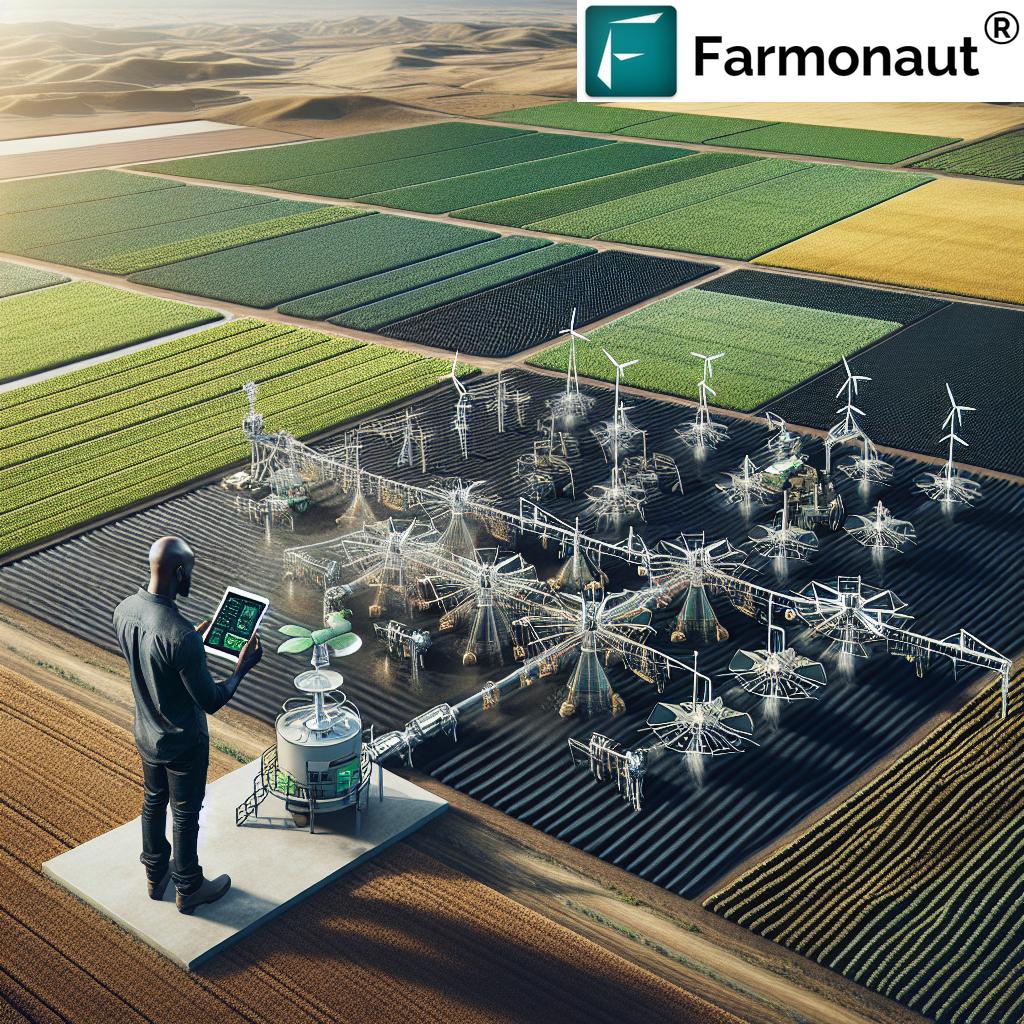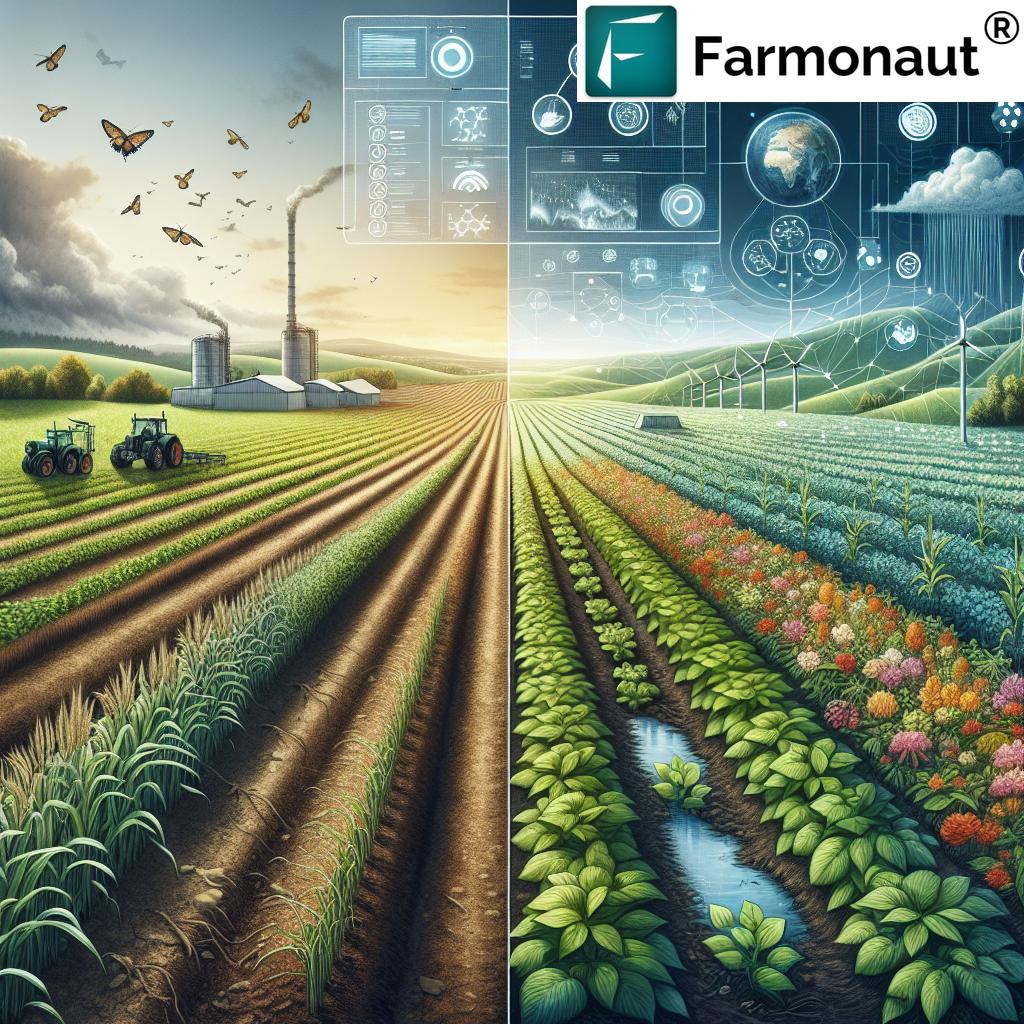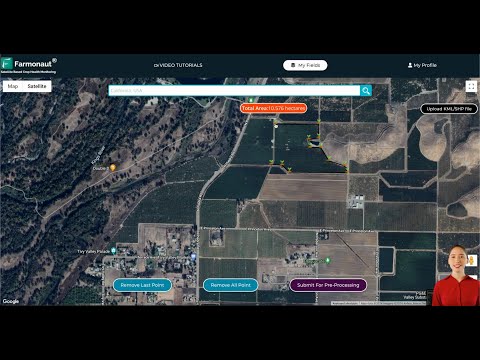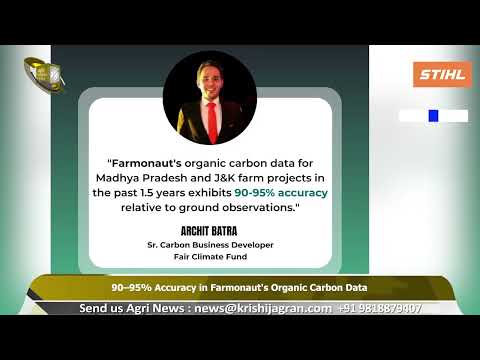Revolutionizing Sustainable Agriculture: How Precision Farming and Remote Sensing Are Shaping the Future of American Crop Production
“Precision farming techniques using clover and bacterial blends can improve crop health while reducing resource usage by up to 30%.”
In the ever-evolving landscape of American agriculture, we find ourselves at the forefront of a revolution that promises to reshape the future of crop production. As we delve into the world of sustainable agriculture practices and soil science research, we’re witnessing a remarkable transformation that’s not only enhancing crop yields but also preserving our precious natural resources. Join us on this inspiring journey as we explore how precision farming and remote sensing are revolutionizing the agricultural industry, paving the way for a more sustainable and prosperous future.

The Evolution of Sustainable Agriculture: A Journey of Innovation
The path to sustainable agriculture has been a long and winding one, marked by continuous innovation and a deep commitment to preserving our planet’s resources. We’ve come a long way from traditional farming methods, and today, we stand on the cusp of a new era in agriculture, one that’s driven by cutting-edge technology and a profound understanding of our natural world.
Let’s take a closer look at how sustainable agriculture practices have evolved over time:
| Time Period | Agricultural Practice | Technology Used | Environmental Impact |
|---|---|---|---|
| Pre-1950s | Traditional Farming | Manual labor, basic tools | High resource usage, limited yield |
| 1950s-1970s | Mechanization | Tractors, harvesters | Increased productivity, high environmental impact |
| 1980s-1990s | Integrated Pest Management | Biological controls, targeted pesticides | Reduced chemical use, improved ecosystem balance |
| 2000s-2010s | Precision Agriculture | GPS, soil sensors, drones | Optimized resource use, reduced waste |
| 2010s-Present | Smart Farming | AI, IoT, remote sensing | Significant reduction in resource usage, improved crop health |
| Present-Future | Sustainable Precision Farming | Advanced remote sensing, AI-driven analytics, Clover and bacterial blends | 30% reduction in resource usage, enhanced soil health, improved crop resilience |
This evolution showcases the remarkable progress we’ve made in agricultural innovation, highlighting the transformative power of technology in shaping sustainable farming practices.
The Role of Precision Farming in Sustainable Agriculture
Precision farming techniques have emerged as a game-changer in the quest for sustainable agriculture. By leveraging advanced technologies, we’re able to optimize resource usage, minimize environmental impact, and maximize crop yields. Here’s how precision farming is revolutionizing the agricultural landscape:
- Site-specific management: Using GPS and GIS technologies, farmers can now apply inputs like water, fertilizers, and pesticides with pinpoint accuracy, reducing waste and environmental impact.
- Variable rate technology: This allows for the precise application of resources based on the specific needs of different areas within a field, optimizing input use and crop yields.
- Soil health monitoring: Advanced sensors and remote sensing technologies provide real-time data on soil moisture, nutrient levels, and overall health, enabling farmers to make informed decisions about crop management.
- Crop health assessment: Remote sensing technologies, including satellite imagery and drones, allow for early detection of crop stress, diseases, and pest infestations, enabling timely interventions.
One of the most exciting developments in precision farming is the use of clover and bacterial blends to improve crop health while minimizing resource usage. This innovative approach harnesses the power of nature to enhance soil fertility, reduce the need for synthetic fertilizers, and promote overall ecosystem health.
Remote Sensing: The Eyes in the Sky Revolutionizing Agriculture
“Remote sensing in agriculture has increased crop yield predictions accuracy by 25% compared to traditional methods.”
Remote sensing technologies have become an indispensable tool in modern agriculture, providing farmers and researchers with unprecedented insights into crop health, soil conditions, and environmental factors. Here’s how remote sensing is transforming the agricultural landscape:
- Satellite imagery: High-resolution satellite imagery allows for large-scale monitoring of crop health, enabling early detection of issues and more accurate yield predictions.
- Drone technology: Unmanned aerial vehicles (UAVs) equipped with multispectral cameras provide detailed, on-demand imagery of fields, allowing for rapid assessment of crop conditions.
- Hyperspectral imaging: This advanced technology can detect subtle changes in plant health, nutrient deficiencies, and even early signs of disease, enabling proactive management strategies.
- Thermal imaging: By measuring temperature variations across fields, thermal imaging can help identify irrigation issues, plant stress, and other factors affecting crop health.
The integration of remote sensing data with other precision farming technologies has led to significant improvements in agricultural resource optimization. Farmers can now make data-driven decisions about irrigation, fertilization, and pest management, resulting in more sustainable and productive farming practices.
At Farmonaut, we’re harnessing the power of satellite-based remote sensing to provide farmers with valuable insights into their crops. Our advanced farm management solutions offer real-time crop health monitoring, enabling farmers to make informed decisions and optimize their operations.

Water Conservation: A Critical Component of Sustainable Agriculture
As we face increasing challenges related to climate change and water scarcity, water conservation in farming has become a critical focus of sustainable agriculture practices. Precision farming techniques and remote sensing technologies are playing a crucial role in optimizing water usage and promoting more efficient irrigation practices:
- Soil moisture monitoring: Advanced sensors and remote sensing technologies provide real-time data on soil moisture levels, enabling precise irrigation scheduling.
- Drip irrigation systems: These water-efficient systems deliver water directly to plant roots, minimizing evaporation and runoff.
- Variable rate irrigation: By combining soil moisture data with topographic information and crop needs, farmers can apply water with precision, optimizing usage across different areas of a field.
- Weather forecasting integration: Advanced weather prediction models help farmers anticipate rainfall and adjust irrigation schedules accordingly, reducing unnecessary water application.
Through these innovative approaches, we’re not only conserving water but also improving crop health and yield potential. The efficient use of water resources is a cornerstone of sustainable agriculture, ensuring that we can continue to feed a growing population while preserving our precious water supplies.
Integrated Pest Management: A Holistic Approach to Crop Protection
Integrated Pest Management (IPM) represents a significant shift in how we approach crop protection, moving away from reliance on chemical pesticides towards a more holistic and sustainable approach. This strategy combines various pest control methods to minimize environmental impact while effectively managing pests and diseases. Here’s how IPM is contributing to sustainable agriculture:
- Biological control: Utilizing natural predators and parasites to control pest populations, reducing the need for chemical interventions.
- Cultural practices: Implementing crop rotation, intercropping, and other techniques to disrupt pest life cycles and promote plant health.
- Monitoring and forecasting: Using remote sensing and predictive models to anticipate pest outbreaks and implement timely interventions.
- Targeted pesticide use: When chemical control is necessary, applying pesticides with precision to minimize environmental impact and preserve beneficial organisms.
By adopting IPM strategies, farmers can significantly reduce their reliance on chemical pesticides, promoting healthier ecosystems and more resilient cropping systems. This approach not only benefits the environment but also contributes to the production of safer, higher-quality food products.
The Role of AI and Machine Learning in Agritech Solutions
Artificial Intelligence (AI) and Machine Learning (ML) are revolutionizing the agricultural sector, providing unprecedented insights and decision-making capabilities. These technologies are at the heart of many agritech solutions, enabling more precise, efficient, and sustainable farming practices:
- Predictive analytics: AI algorithms can analyze historical data, weather patterns, and current field conditions to predict crop yields, pest outbreaks, and optimal harvest times.
- Automated crop monitoring: Machine learning models can process vast amounts of satellite and drone imagery to detect early signs of crop stress, disease, or nutrient deficiencies.
- Smart irrigation systems: AI-powered irrigation systems can optimize water usage by considering factors such as soil moisture, weather forecasts, and crop water requirements.
- Robotic farming: AI-driven robots and autonomous vehicles are being developed for tasks such as planting, weeding, and harvesting, reducing labor costs and improving efficiency.
At Farmonaut, we’re leveraging AI and ML technologies to provide farmers with powerful tools for agricultural resource optimization. Our API and developer documentation enable integration of our advanced satellite-based monitoring and AI-driven insights into various agricultural applications.
The Impact of Climate Change on American Agriculture
As we navigate the challenges of sustainable agriculture, we cannot ignore the significant impact of climate change on American farming. Rising temperatures, changing precipitation patterns, and more frequent extreme weather events are reshaping the agricultural landscape. Here’s how precision farming and remote sensing technologies are helping farmers adapt to these changes:
- Climate-resilient crop varieties: Advanced breeding techniques and genetic research are developing crops that can withstand changing climate conditions.
- Adaptive farming practices: Precision farming technologies enable farmers to adjust planting dates, irrigation schedules, and crop management strategies based on changing climate patterns.
- Carbon sequestration: Sustainable agriculture practices, such as cover cropping and reduced tillage, are being promoted to increase soil carbon storage and mitigate climate change impacts.
- Early warning systems: Remote sensing and predictive modeling help farmers prepare for and respond to extreme weather events, minimizing crop losses.
By embracing these innovative approaches, we’re not only adapting to climate change but also contributing to its mitigation through more sustainable farming practices.
The Future of Sustainable Agriculture: Emerging Trends and Technologies
As we look to the future of sustainable agriculture, several exciting trends and technologies are emerging that promise to further revolutionize the industry:
- Vertical farming: Urban agriculture solutions that maximize space and resource efficiency, bringing food production closer to consumers.
- Blockchain in agriculture: Enhancing traceability and transparency in the food supply chain, ensuring food safety and authenticity.
- Gene editing: Developing crop varieties with enhanced resilience to pests, diseases, and environmental stresses.
- IoT in agriculture: Expanding the use of connected sensors and devices to provide real-time monitoring and control of farm operations.
- Regenerative agriculture: Focusing on practices that not only sustain but actively improve and regenerate the health of agricultural ecosystems.
These innovations, combined with ongoing advancements in precision farming and remote sensing, are paving the way for a more sustainable, resilient, and productive agricultural future.
Empowering Farmers with Farmonaut’s Solutions
At Farmonaut, we’re committed to making precision agriculture accessible and affordable for farmers worldwide. Our platform offers a range of tools and services designed to empower farmers with the insights they need to optimize their operations and embrace sustainable farming practices:
- Real-time crop health monitoring: Our satellite-based monitoring system provides up-to-date information on vegetation health, soil moisture, and other critical metrics.
- AI-powered advisory system: Our Jeevn AI tool delivers personalized farm management advice, helping farmers make informed decisions about crop management and resource allocation.
- Carbon footprint tracking: We offer tools to help agribusinesses monitor and reduce their environmental impact, promoting more sustainable operations.
- Fleet and resource management: Our solutions help optimize the use of agricultural machinery and resources, reducing operational costs and improving efficiency.
We invite you to explore our range of solutions and see how Farmonaut can help you embrace the future of sustainable agriculture:
Conclusion: Embracing a Sustainable Agricultural Future
As we reflect on the remarkable journey of agricultural innovation, from traditional farming methods to the cutting-edge technologies of today, we’re filled with optimism for the future of sustainable agriculture. Precision farming techniques and remote sensing technologies are not just improving crop yields and resource efficiency; they’re fundamentally transforming our relationship with the land and our approach to food production.
The challenges we face, from climate change to water scarcity, are significant. But through the power of innovation, collaboration, and a deep commitment to sustainability, we’re developing solutions that promise a more resilient, productive, and environmentally friendly agricultural future.
As we continue to push the boundaries of what’s possible in agriculture, let’s remember that each advancement, each new technology, and each sustainable practice brings us one step closer to a world where abundant, nutritious food is produced in harmony with our planet’s ecosystems.
Together, we can revolutionize agriculture, ensuring a sustainable and prosperous future for generations to come.
Frequently Asked Questions
- What is precision farming?
Precision farming is an agricultural management concept that uses technology to observe, measure, and respond to variability in crops, optimizing resource use and improving yield. - How does remote sensing benefit agriculture?
Remote sensing provides valuable data on crop health, soil conditions, and environmental factors, enabling more informed decision-making and proactive management strategies. - What role does AI play in sustainable agriculture?
AI helps analyze vast amounts of data, providing insights for better decision-making in areas such as crop management, resource allocation, and pest control. - How can farmers start implementing sustainable agriculture practices?
Farmers can begin by adopting technologies like soil sensors, implementing integrated pest management, and using precision irrigation systems. - What is the future of sustainable agriculture?
The future of sustainable agriculture involves continued integration of advanced technologies, focus on regenerative practices, and adaptation to changing climate conditions.






